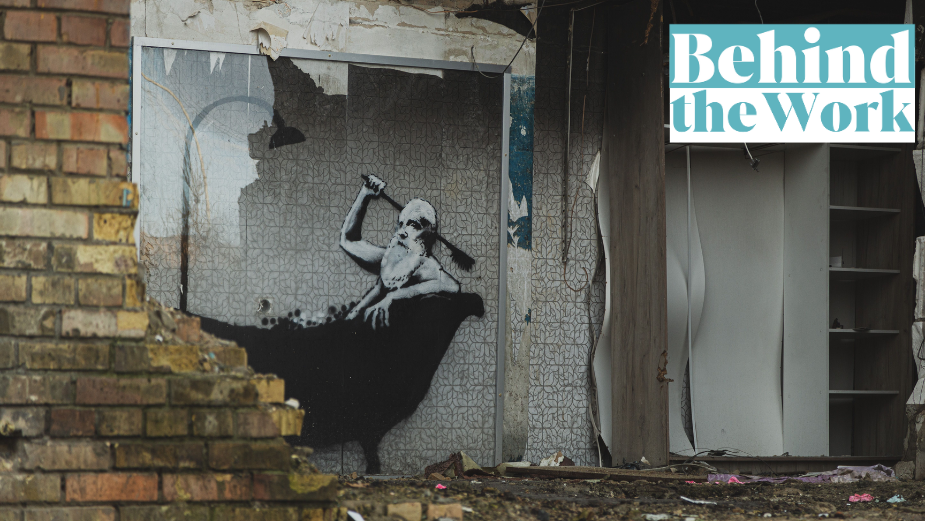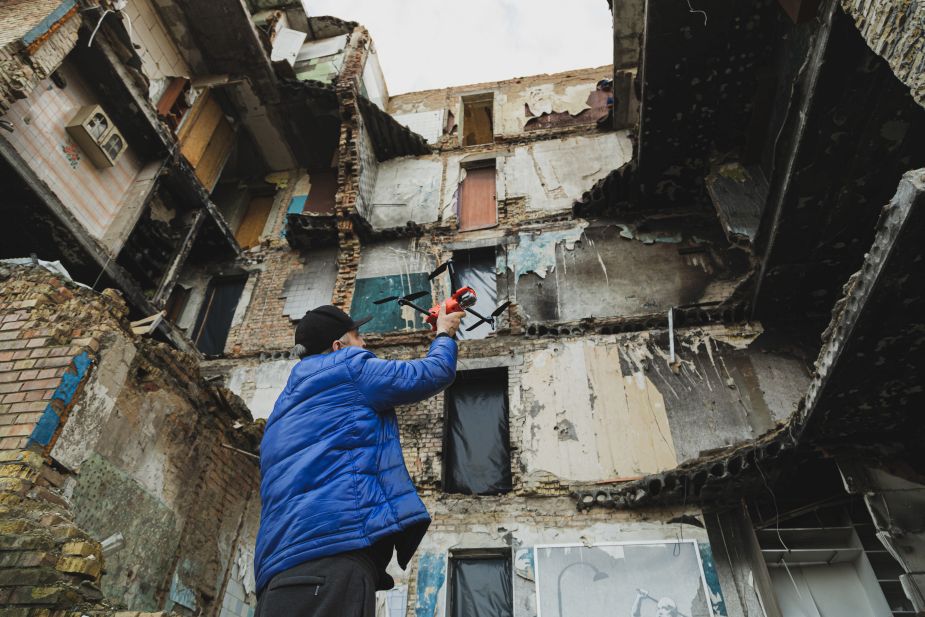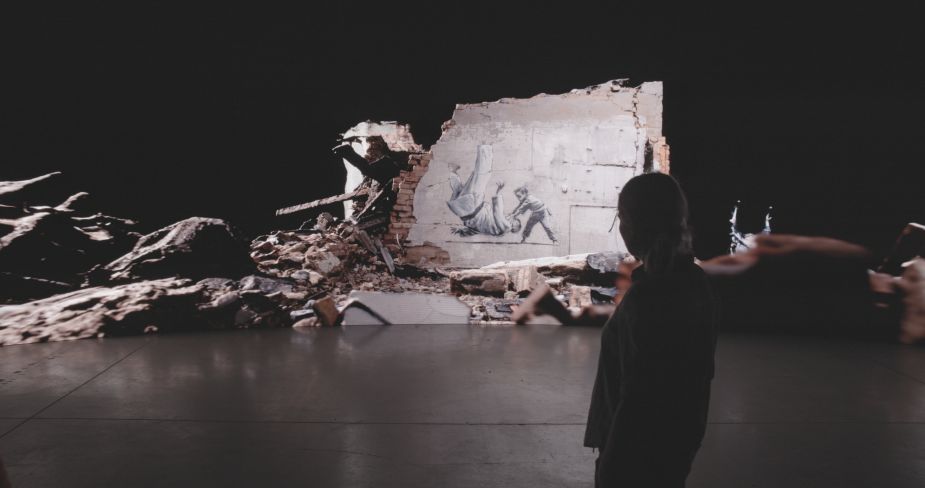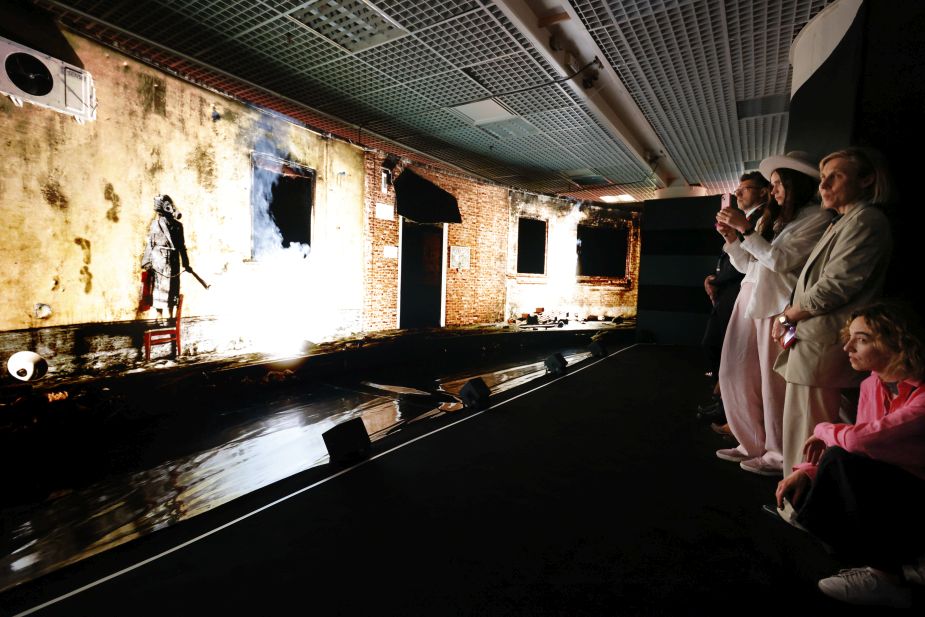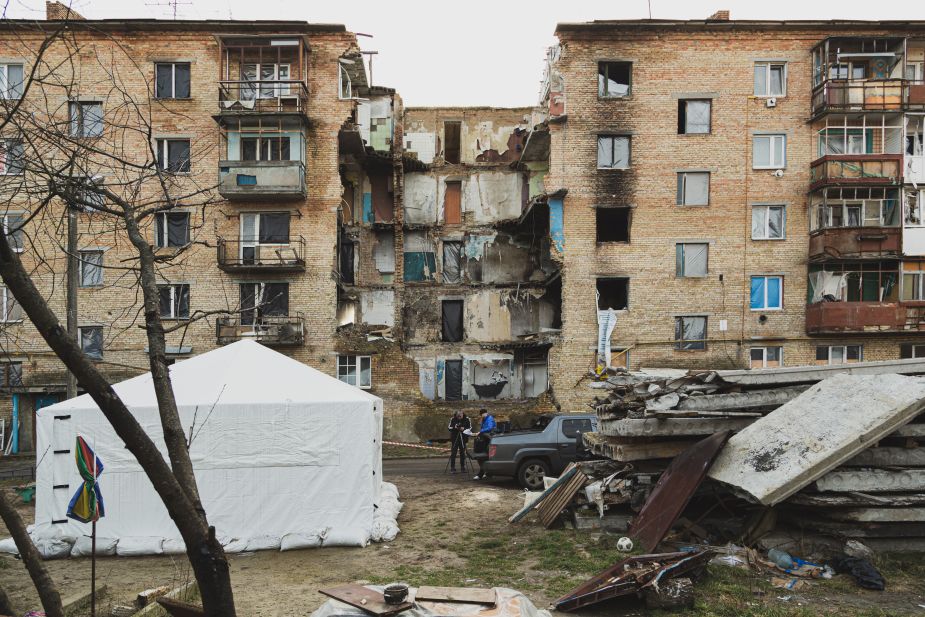MURALS: How an Immersive Take on Banksy’s Artwork Confronted the Reality of the Conflict in Ukraine
-

-
There’s no ‘right’ way to tell the story of a war. Since Vladimir Putin first took the decision to send his country’s armed forces into Ukraine in 2022, excellent journalists and documentary filmmakers have shone a light on the dark conflict, bringing us understanding and visibility. But in order to communicate the intensely personal feelings of loss – and the broader human impact of this war – other storytelling devices are necessary.
Irpin – a city located in the Kyiv Oblast – is the hometown of 3D artist Artem Ivanenko. And it was on a trip back to Irpin, after it had been targeted during the early days of the Russian invasion, that Artem resolved to capture the reality of what he saw.
Using 3D scanning, the Ukrainian artist was able to take an astonishingly detailed snapshot of his hometown at a critical moment of the conflict. The scans, which serve both as evidence of the Russian army’s brutality and a historically significant document, have since been used to create MURALS.
A groundbreaking immersive experience confronting the reality of the Ukrainian conflict, MURALS came to life at the Cannes Film Festival on May 18th. Behind the scenes of the exhibition was art director and animator Federico Gonzalez Montoya, alongside producers Radka Bardes and Maciej Zemojcin with the help of the Polish Film Institute. To direct the project, Aggressive’s co-founders Alex Topaller and Dan Shapiro joined the team.
To find out more about the project and the unique story of how it came together, LBB’s Adam Bennett spoke to Artem, Federico, Radka, Maciej, Alex, and Dan…
-
LBB> Artem, can you tell us more about how your journey back to Irpin gave life to this project?
-
Artem> When we had to leave our home in the city of Irpin for one month, we never stopped monitoring the situation in the city – and particularly around our house. During the first week, we kept an eye on the cameras located in our apartment. We could see the surroundings and understood that everything was fine. After a week, the last battery ran out, and we were left ‘blind’. We only had access to news on the internet, and occasionally via low-quality photos from local military personnel.
We saw our house in the photos, we saw the traces of artillery hits, and the traces of fire, but we couldn’t make out what was happening to our apartment – the angle and quality didn’t allow us to do so. It was then that the subconscious mind provided a solution – why couldn’t we rotate the angle in the photo as we needed?
Upon returning to the still closed-off city as part of an initiative group, I was able to assess everything with my own eyes. I saw many other things, things that had already disappeared, been cleared away, or rebuilt by the time the residents returned to the city.
It was at that moment that the decision was made to use the technology of high-detail reference 3D scanning (which I was already familiar with before the war and used in my projects) to preserve and disseminate information about the war. The problem with photography is that it can be unreliable. Taking a photo from the wrong angle during a war usually doesn’t offer a second chance, which means that the information is irretrievably lost for everyone.
-
LBB> And how did that then evolve into MURALS?
-
Artem> At the time of my return, I didn’t plan on launching a creative project. At that moment, I had two goals – to gather as much data as possible and to disseminate this data widely in the world. However, unfortunately, by that time, there was already a fatigue effect regarding information about the war in the world. Therefore, pure documentary content wouldn’t have had the desired impact I was hoping for.
It was only a little less than a year later when Maciej, Radka, and I started discussing a possible project at the Cannes Film Festival that the form of my project began to take a creative direction. Cannes is more about creativity than pure documentary filmmaking.
But fortunately, Maciej and Radka – together with Alex and Dan – helped to turn these 3D scans into something moving and beautiful.
-

-
LBB> Dan and Alex, how did you first come to be involved in this project?
-
Dan> Of course, MURALS only became possible because of Artem’s incredible work. It all expanded from his 3D scans which told a story of the destruction wrecked by Russian forces before their initial withdrawal from the more Western parts of Ukraine last year. From there the conversation spread to Maciej and Radka – and there was a nebulous idea that we wanted to make this into something.
The compelling thing about Artem’s 3D scans is that they kept a kind of record of the damage and what happened there. It’s historic evidence. So Artem, Maciej, and Radka reached out to us to help bring a story to life built around this extraordinary evidence.
Alex> Seeing the scans for the first time was intense, so we wanted to get involved right away. Of course the whole world is following the news, but at a certain point it becomes mentally difficult to place yourself inside the reality of what’s happening on the ground. So any tools that allow people to understand the scale of the tragedy and the extreme urgency of the current situation on a fundamental level is key – this pushes our governments to act, even when there is little political will to do so.
-
LBB> Federico, what was your vision at the outset, and how closely does it align with the finished experience?
-
Federico> When we received the scans from Artem and saw how impressive and powerful these three-dimensional figures were, I think that we all knew that we had to maintain attention and prominence only to the buildings. We wanted to tell war stories only through light, trying to keep Artem’s work as faithful as possible.
Initially, we considered adding shadows of animated people projected onto the buildings, but we quickly realised that it would eclipse the structures and with the addition of too many layers to something that was already very deep, we didn’t want to overshadow Artem’s work with unnecessary noise.
-

-
LBB> Radka, how did you and Maciej get involved?
-
Maciej> The project started for us when Artem sent me the first 3D scans of destroyed Russian tanks. But in reality, these kinds of scans are not so interesting for the broader public, as we are inundated with information about various wars in the form of entertainment content. We are overwhelmed with war-themed video games, action movies, historical films, etc. It was only Radka’s idea to base the story on Banksy’s murals that initiated the entire creative process.
Radka> Banksy is intriguing, so everyone will start wondering, why did he actually go to Ukraine? And why is Banksy intriguing: because it’s art worth thousands and millions, laying on the street. People don’t understand this, which is why they’re so intrigued by what Banksy is trying to say. And that’s how it all started, it was the key for Western European viewers to understand Ukraine.
-
LBB> What was it about Banksy’s art which you found particularly inspiring?
-
Dan> Banksy’s murals exist on these structures in their own context. Since Banksy originally painted these murals on a trip to Ukraine, they have been framed or isolated separately because many of the buildings they were drawn on have been destroyed or fallen down. And I just don’t think they have the same impact without the context of the buildings as they were, in the state they were. So I think it can only be a good thing to showcase these murals within the context in which they were originally created.
Alex> On that point, I think we are very careful in that we don’t want to overstep or be distasteful in making ‘art’ out of this destruction. So it is important to us, when it comes to the murals, that we give them this honest context.
Artem> There is a deep hidden meaning in all of Banksy’s work. This is exactly what distinguishes it work from other street artists. Each mural tells a story, has a hint, has a connection to an event or a place. And to understand that connection, you don’t just have to look at the picture, you have to think about it. It seems to me that his works in Ukraine can become a world cultural heritage alongside the classic world masters of paints and brushes.
-
 19.05.2023 Foto: Sebastian Gabsch
19.05.2023 Foto: Sebastian Gabsch
-
LBB> And how have you been finding the feedback so far?
-
Alex> It’s been really powerful. Watching people walk out of the exhibition at Cannes was quite harrowing – a lot of shocked faces and people being visibly affected. That being said, it wasn’t ever our specific goal to simply make sure people cried or felt emotional – we want to make sure this conversation doesn’t stop and the voices of Ukraine are amplified. To that end, our hope is that it’s going to travel to other locations. We’re having conversations about New York, Toronto, and the UK right now. It’s sadly easy to get crisis-fatigue from watching or reading the news. We want to cut through that.
Federico> We’ve felt the energy of the viewers looking on at the war’s destruction and madness. Something that really surprises us has been all the small stories you can create by looking at the details of this kind of 3D structures: the baby carriage of the kindergarten, the hole behind the dancing girl, the Van Gogh Painting abandoned outside the Horenka Building being three examples.
-
LBB> What was the biggest challenge you encountered, and how did you overcome it?
-
Artem> There were two core challenges that I needed to overcome. The first was to stop crying when you see a burnt-out baby shoe, and just do your thing. To treat it like your job – no emotions, just cold thoughts.
The second is simply the paper bureaucracy in a country that has only grown stronger with the war. It is very difficult to get permission to shoot. Since I am not a journalist and have no journalistic accreditation, obtaining any kind of permission is almost impossible. Sometimes I have to act a little outside the law, but it’s within the bounds of reason.
Federico> Every studio project has certain challenges, especially technical ones because we tend to focus on non-conventional and big formats. This one was no exception! The resolution was pretty big, and we wanted to reach a certain photographic reality. Fortunately, we found that working with Unreal Engine a fast and reliable tool to reach deadlines whilst maintaining the expectations we wanted.
Maciej> Murals is a project with a mission. In our view, it was bound to happen. The hardest part is to talk about war in a way that still moves people, helping them see that behind it lies a real human tragedy, not just some abstract ‘military action.’ The key is to deliver an important message in an engaging manner. This project carries a mission, but it also needs to adhere to the rules governing today’s media and visual communications. Murals is a valuable project presented in an engaging way. This was our greatest challenge.
Alex> This isn’t a challenge per se, but something I want to make clear is that this project isn’t an attempt to represent the whole of Ukraine. All of what we see in MURALS is from the Kyiv region, obviously based on the scans taken by Artem of his hometown and the surrounding areas – in a way it captures the very first few months of the war.
Both these artworks and the war crimes being perpetrated are tragically ephemeral, to a certain degree. But this project freezes that moment in time. It’s preserving it. That was always our goal.
-

-
LBB> And finally, is there anything that you’d do differently if you had your time again?
-
Maciej> This project isn’t finished because the war in Ukraine hasn’t ended. We’re not looking at what we could have done differently, but rather at what we will do next with the Murals, how this project will evolve. Currently, we have over twenty invitations from around the world: from Europe to the USA, to Japan.
This message is just beginning to reach the audience, and we believe it will cause waves and reactions that Ukraine needs. We would not be able to accomplish this project and such a wide audience without help from the Polish Film Institute, which was the first in Europe to create a special fund to support Polish – Ukrainian initiatives.
For anyone interested in learning more about the project, we invite you to visit our Instagram. Here, you’ll find information on where you can see Murals in the near future. We welcome you to join us – it’s important!
